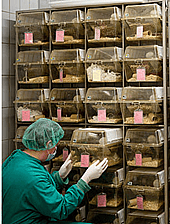Work at off-site or contract animal care facilities (ACFs) is becoming more and more common. This blog focuses on important safety-related considerations for off-site ACF work.
Whose safety program are your employees working under?
The safety of the employees conducting off-site work is the responsibility of the employer. Don’t assume that all employee safety considerations are being handled by the off-site facility, as that’s often not the case. Understand what is being provided by the ACF and determine if you need more, like an ACF safety manual and ACF training to cover employee safety issues such as animal allergies, the importance of getting a tetanus vaccination, and how to manage animal bites.
Understand if the development of animal allergies is being monitored and what your employees’ respirator needs are
The off-site ACF you’re working with may be administering initial animal allergy questionnaires that get submitted to an occupational health center for evaluation. Based on the information provided in the questionnaire, the occupational health physician may require that the employee wear an N95 respirator, in other cases respirator use may be voluntary.
It’s important to obtain a copy of the occupational health clearance letters so you can determine if it’s necessary to implement a full respiratory protection program for any employees required to wear a respirator, or if your employees should be signing the OSHA Appendix D form for voluntary respirator use.
In addition to the initial animal allergy questionnaire, Safety Partners recommends that employees who work in ACFs complete and submit the questionnaires to occupational health on an annual basis in order to be proactive in preventing animal allergies.
Determine if exposure monitoring is needed
If isoflurane is being used, it’s likely that the off-site ACF is not evaluating your employees’ exposure. Baseline exposure monitoring of employees working with isoflurane is highly recommended.
Currently, there is no OSHA permissible exposure limit (PEL) for isoflurane, but OSHA has published guidance for inhalation anesthetics in general. NIOSH has established a recommended exposure limit (REL) of 2ppm for a 1-hour exposure to halogenated inhalation anesthetics. Because these agents have been linked to reproductive toxicity and developmental effects, it’s important that employees’ exposure be evaluated.
Understand what is traveling where
Know what’s being transported between your facility and the off-site animal care facility. Determine it’s being done correctly, and if you should be developing a written transport policy and conducting training, especially if you are transporting controlled substances.
If dry ice, small quantities of solvents, formalin, and/or tissue samples are being transported the DOT Materials of Trade (MOT) requirements may apply.
Know what the plan is for reporting incidents and accidents
It’s important to determine the ACF’s incident reporting procedures. What if one of your employees has an incident at the off-site facility? Who is responsible for documenting it, and who is responsible for contacting local boards of health? There are city and town-specific reporting requirements if there is a potential exposure to infectious material, and that includes exposures from animal bites and needle sticks. For instance, Boston has its own specific form for reporting animal bites, so it’s important to figure out who is responsible for completing and submitting it.
Make sure your Safety Partners’ consultant knows you are doing off-site ACF work
If your consultant understands the depth and breadth of your work, they can make recommendations on your off-site ACF safety needs such as additional training, isoflurane exposure monitoring, and distributing and tracking annual allergy questionnaires.
Don’t hesitate to ask your Safety Partners’ consultant to do a walkthrough of the off-site animal care facility. It is a great way to assess your needs and determine which safety program elements should be implemented.
Learn more about how Safety Partners can support your offsite ACF work here.
This blog was written by Beth Graham, our Associate Director of Quality, Research, and Training.

